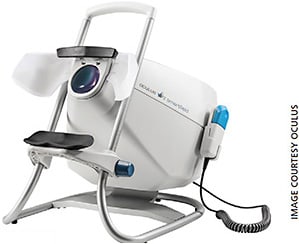Oculus is once again reinventing its perimeters. The company recently introduced the Smartfield, a compact, screen-based perimeter. Its predecessor, the Oculus Easyfield, was designed for use as a screener and a threshold perimeter for “immediate re-examination of abnormal findings” within the central 30°.1 The Smartfield is optimized for central and peripheral visual fields up to 60°, including monitoring functional impairment in glaucoma.
COMPACT AND ERGONOMIC
The Smartfield weighs in at 16.8 lbs and has a built-in carrying handle, so it can be transported from one exam room to another.2 Additionally, it can be used under normal room lighting, which saves both practice space and resources. A separate dark room is not required, allowing staff to better multitask — more light means they can monitor a patient undergoing a field test while performing duties such as paperwork.
Other time-saving features include translucent lateral shields, which replace the customary eye patch, and the removal of refractive correction for presbyopic patients.3

IN PRACTICE
Marta Gonzalez-Hernandez, who has a BSc and Masters in Optometry as well as two PhDs, is an optometrist in the ophthalmology department at the Hospital Universiario de Canarias, Spain. She has been using the Smartfield since it was a prototype.
“In clinical practice, we appreciate ergonomic and efficient solutions,” she says. Another advantage of the Smartfield, she notes, is the ultra-high-luminance LCD screen, which generates both the background illumination for the test and the test stimulus target,” Dr. Gonzalez-Hernandez says. “Differential thresholds are more stable when the background and stimulus are of the same light source.”
TESTING STRATEGIES
In addition to offering the traditional “Full Threshold” and “Fast Threshold” strategies, this technology offers the SPARK rapid perimetric strategy.
SPARK is designed to repeat a short examination of specific statistically significant points capable of providing precise, useful information. Rest periods between phases allow recovery of the physiological contrast mechanism.
“Many short tests over time provide more accurate information than one isolated long test,” Dr. Gonzalez-Hernandez says. “From a clinical perspective, the SPARK Precision examination strategy is short, lasting approximately three minutes per eye, which is similar in time to TOP [Tendency-Oriented Perimetry] or SITA [Swedish Interactive Threshold Algorithm]-Fast. SPARK has the advantage of performing the field test in four phases, each being quite accurate, then averaging them. This makes the results very stable, with few fluctuations when performed completely.”
She adds that the first phase, SPARK Quick, can be taken on its own as a screening strategy; alternately, it also offers “SPARK Training” for orientation purposes.
Dr. Gonzalez-Hernandez was instrumental in developing the SPARK testing strategy.4 She and others observed that visual field results deteriorated with prolonged testing due to fatigue of the retinal contrast function. Other strategies yielded unstable estimates of threshold, and averaging multiple long tests to get a real threshold is not clinically practical. Another obstacle: The fluctuating results made it difficult to determine disease progression.
Using the SPARK results, the Smartfield offers Predicting Anatomy from Thresholds (PATH).2 These algorithms provide information about the retinal nerve fiber layer thickness TSNIT circle and display it as a Cartesian representation or as a conventional function-structure display, mirror inverted for convention. Defect assessment is done with the Glaucoma Staging System, which uses mean defect and pattern standard deviation. A Glaucoma Staging Program uses algorithms to determine the degree of risk of the glaucomatous stage based on the test results, while the Threshold Noiseless Trend module can monitor changes over time.
POINTS OF COMPARISON
Dr. Gonzalez-Hernandez explains the printouts from the Oculus Smartfield and Humphrey Field Analyzer are similar, so the interpretation is intuitive for those familiar with the latter.
“No two instruments from different device manufacturers are ever completely interchangeable. Even though the dynamic ranges of both instruments are very similar, the strategies used are different. For example, the Smartfield 24-2 does not examine the very upper and lower rows, but it tests more points in the horizontal meridian.”
CONCLUSION
The Smartfield with external computer and glaucoma suite software will cost about $14,000. Says Dr. Gonzalez-Hernandez: “This perimeter offers stable, differential, averaged thresholds in a compact and efficient design for any ophthalmic office space.” OM
REFERENCES
- OCULUS Easyfield. https://www.oculus.de/en/products/perimetry/easyfield/highlights/ Accessed Oct. 14, 2018.
- OCULUS Smartfield Technical Specifications. OC/1985/WZ/EN P/14000/EN.
- New OCULUS screen-based perimeter. Oculus press release. September 12, 2018.
- Gonzalez de la Rosa M, Gonzalez-Hernandez M. A strategy for averaged estimates of visual field threshold: SPARK. J Glaucoma 2013;22:284-289.








